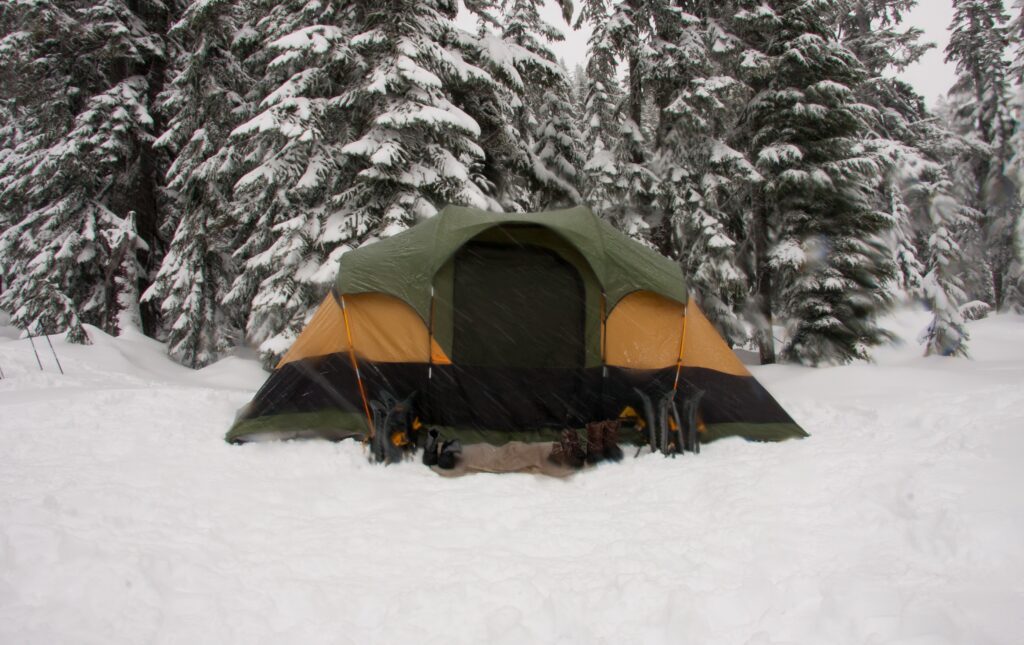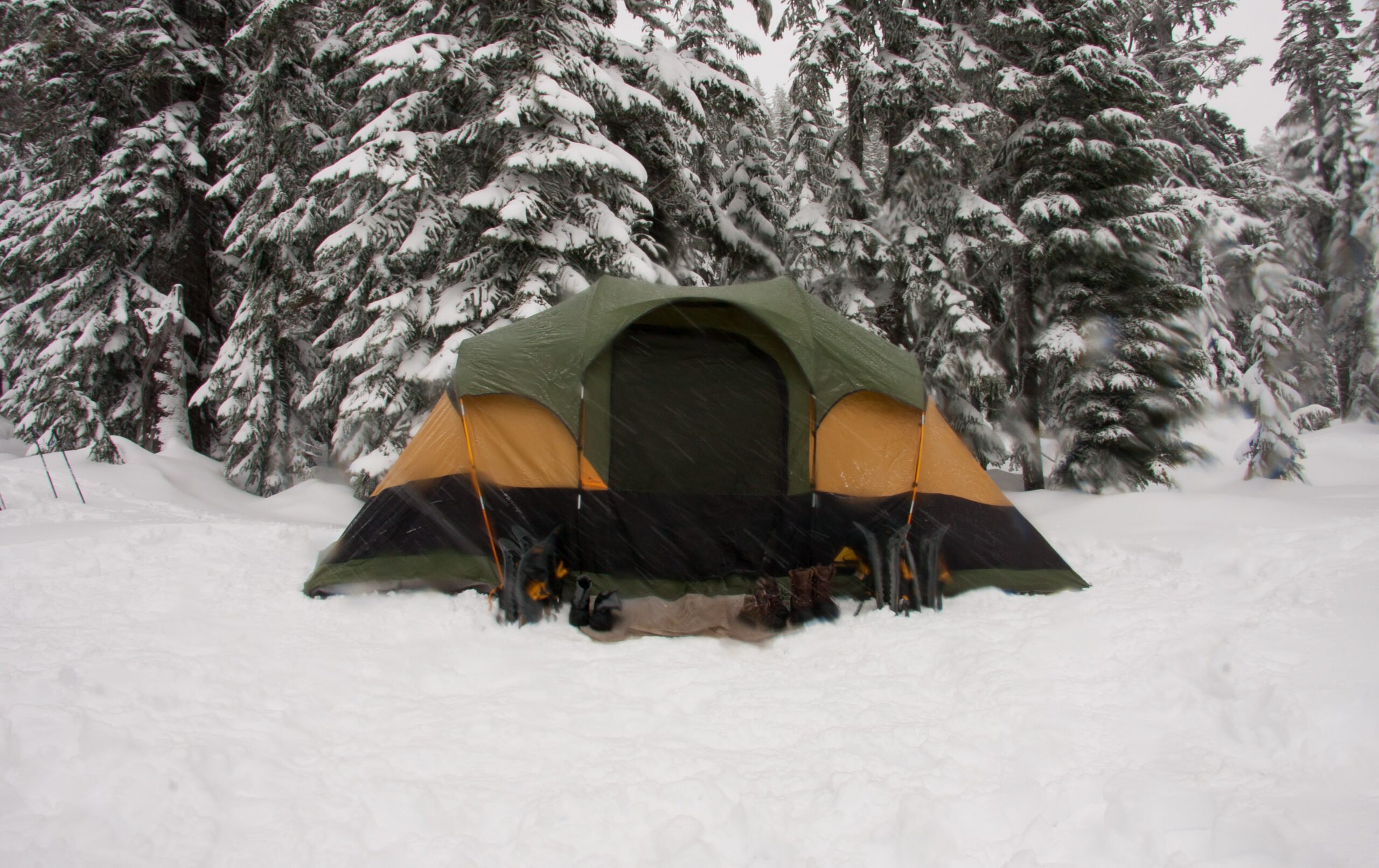Camping in the snow can be challenging due to the unique obstacles it presents. From cold temperatures to frozen surfaces, camping in the snow requires extra measures so that the overnight stay is comfortable. The key to making your camping trip pleasant is by keeping yourself warm and dry. With the right clothes and gear, that shouldn’t be too difficult.
Waterproof clothes and shoes, thermal clothing, and heating equipment are mandatory to protect yourself from the negative-degree temperatures in the snow. You must also build a big fire to stay warm throughout the night. Plus, you should drink lots of water and keep your stomach full to stay warm.

How to Stay Dry and Warm When Camping in the Snow
To survive in the outdoors amidst the harsh winter climate, you must take all necessary measures to keep yourself warm and dry at all times. The first and the most important rule is to layer up your clothing with base layers, mid-layers, and windbreakers. However, this might lead to sweating which when cooled will make you feel colder. So you must change into other clothes as soon as you start to sweat.
If you do not have a problem carrying two sleeping pads for you, absolutely do so! Two sleeping pads will keep you more insulated on the cold ground and help you achieve a good sleep throughout the night. To keep your body warmer, you may use a hot water bottle inside your sleeping bag (preferably positioned on the core of your body).
Although it might sound counter-intuitive, you should have proper ventilation in your tent. Breathing inside an enclosed tent leads to the hot vapor turning into water droplets. They will later condense and freeze so you’ll be left in an icebox by the morning. To prevent that from happening, keep the vents in your tent slightly open.
Where to Set Up a Tent When Camping in the Snow
Selecting a tent spot for camping in the snow should be well-thought. Ideally, plain and clear areas are suitable. However, you should contact a local guide to find out if your desired spot is prone to avalanches. You shouldn’t set up your camp anywhere near the risk-prone area. Also, find out if there are water bodies near the camping area. If so, you must ensure that there’s no chance of you accidentally walking on ice.
Overhead trees could be hazardous if not looked out for. Usually, in the snowy area, the snow weighs down the tree which might lead them to drop in the tent. Therefore, avoid setting up your tent near trees that look dead, decayed, or have huge branches hanging over. They’ll most likely fall on the tent at some point, causing major accidents. Look at the overall health of the tree before setting up your tent under it.
Things to Do When Camping in the Snow
If you are at the camp with your friends or family there are so many recreational activities that fit a snow site. You can have competitions for building snowman or play tug of war with a snow wall as the middle mark. If you have a frozen lake nearby, get brooms and a tennis ball to play snow hockey on the ice!
You and your family can go for ice fishing while making sure that everyone is bundled up in warm clothes. This is a suitable activity only if your campsite is nearby so that you can go inside the tents and warm up as soon as you’re done fishing.
Snow slides fall under fun activities especially if you have kids with you. However, you must ensure that all sorts of harmful items that can cause injuries are cleared out of the slide such as logs, rocks, stumps, old cans, etc.
If you happen to have an HD camera at hand, get lost in winter photography as there will be multiples frames you would want to capture in the snow. It’s a fascinating hobby to explore especially in environments where nature is at its best.
List of Useful Waterproof and Warm Camping Gear
- Tent
- Before you decide on the right tent to bring to your camp in the snow, talk to a guide or a local to find out what the ideal type of tent is that can withstand the cold in the chosen area. Peak winter may require a fully-enclosed 4-season tent while camping in the snow during early spring could be viable with a standard 3-season tent.
- Since days in the winter are shorter, you’ll most likely spend more time inside the tent than be exposed to the cold temperate outside so it’s better to invest in a large tent. Also, the shape of the tent is crucial in snowy weather. A dome tent with steep sides will prevent the snow from getting collected on the top of the tent.
- Sleeping Bag
- When choosing the sleeping bag for camping in the snow, you should look at the “temperature rating” on the cover of the bag. Ideally, the temperature rating on the sleeping bag should be ten to twenty degrees lower than the actual temperature. So, if you’ve chosen a camping area which forecasts lows of thirty-degree Fahrenheit, you should bring a sleeping back which has the temperature rating of ten to twenty degree Fahrenheit.
- Light
- With lesser daylight in the winter, carrying a sufficient amount of sources of light is important. You may carry lamps or lanterns if possible. Otherwise, you should have at least two torches and a waterproof match container to get you through the night.
- Extra Clothing
- Layering is crucial to fight against low temperatures. While you should be wearing multiple layers of clothes, we’d suggest you bring extra ones just in case the outer layers of clothes become wet from all the cold, white fluff around you.
- Heated Boots, Hand Warmers, and Gloves
- Heater boots, hand warmers, and gloves are compact solutions to keeping yourself warm in the harshest cold temperatures. To function properly in the snow, you need to keep your toes and fingers warm at all times. Therefore, make sure to pack your favorite pairs of these warmers so that you can enjoy your camping trip to the fullest.
- Heater
- Sometimes temperature in snowy areas can be so low that it’s not humanly possible to withstand camping comfortably. In such situations, a heater is necessary. You can choose from various types of heaters to bring to your camping sites such as electric heaters, halogen heaters, and gas heaters.
Although they will keep you warm, you should take certain precautions in case of each of these heaters. For an electric heater, never leave it unattended and always keep the auto-shutoff timer on. Gas heaters should only be utilized in areas with proper ventilation as there are multiple ways it could cause accidents such as gas leaks and carbon monoxide poisoning. In the case of halogen heaters, the safest way to use them is by hanging them at the center of the tent.
Conclusion
With the ideal clothing, shelter, and gear, camping in the snow can be as delightful as it is in the warmer months. As long as you protect yourself and your friends and family from the harsh weather conditions, you can create wonderful memories in the outdoors no matter how snowy it is.
References:
- https://www.backpacker.com/news-and-events/beginners-guide-to-winter-camping
- http://www.lovetheoutdoors.com/how-to-camp-in-the-snow/
- https://www.wildlandtrekking.com/blog/5-tips-for-camping-in-the-snow/
- https://www.msrgear.com/blog/9-tips-for-staying-warm-while-winter-camping/
- http://www.inquiry.net/outdoor/winter/activities/index.htm

